Preparing to welcome a greyhound puppy into your home? If so, you’re likely seeking breed-specific information to help you best raise and support your new canine companion.
In this guide, we’ll provide an overview of the greyhound breed, discuss crucial milestones and greyhound progression timelines, and offer tips for supporting the development of a happy, confident, and healthy greyhound.
Read on to learn more.
Greyhound: Breed Summary
Scholars tend to agree that the greyhound is the oldest known purebred, domesticated dog breed. These ancient pups have roots dating back to the era of the Egyptian pharaohs. Estimates of their origins typically range from 4,000-8,000 years ago in Ancient Egypt. Some historians suggest that the royal class revered these graceful, sleek dogs and disallowed lower classes in Egyptian society from owning them. In Egypt, royalty primarily kept them for small game hunting and as graceful companions.
Greyhounds are sighthounds, meaning that they hunt primarily from sight rather than scent. All sighthound breeds are descended from the ancient greyhound of Egypt. These dogs appear in Greek and Roman mythology, likely from these cultures’ interactions with Egyptian society. By the 15th century, the greyhound was quite the popular breed among the wealthy classes across various parts of Western and Central Europe, especially around the Mediterranean nations, Britain, and Ireland. By this time, the nobility particularly enjoyed greyhounds as racing dogs and hunters of hares. Likely, racing greyhounds began as a sport in Ancient Egypt and Greece.
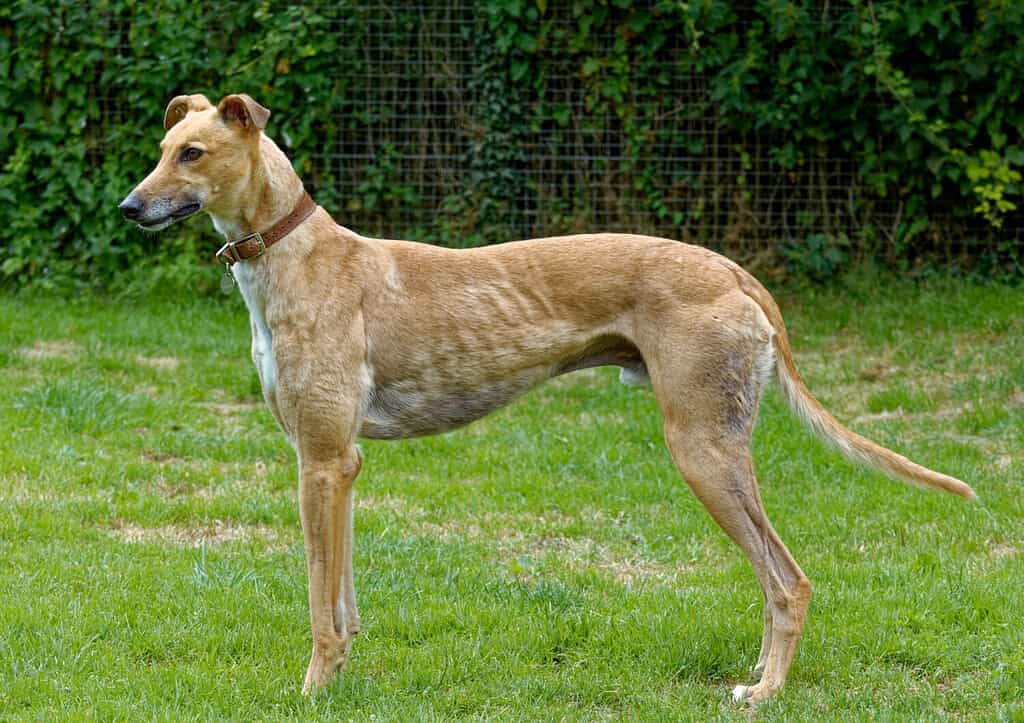
The greyhound is the oldest purebred, domesticated dog breed, originating in Ancient Egypt.
©Colin Seddon/Shutterstock.com
Racing Greyhounds
In ancient times and today, racing greyhounds is a dangerous and cruel sport that frequently ends in deaths and injuries. According to the Humane Society of the United States, a racing greyhound died every 3 days on a Florida coursing track when they were still operational. Additionally, the lives of racing greyhounds are overwhelmingly inhumane, as the dogs are typically isolated and confined to kennels for 20-23 hours a day.
According to the ASPCA, common injuries that racing greyhounds endure include severed toes, broken legs, spinal cord injuries including paralysis, broken necks, and cardiac arrest. Today, greyhound racing is banned in 42 states due to these severe welfare outcomes, and an additional 7 states have ceased racing in the past few years. Florida officially ended greyhound racing in 2020. Currently, West Virginia is the only state with active live greyhound racing. For thousands of dogs saved from the lives of forced racing and containment, greyhound rescues have stepped up to foster and find them loving, adoptive homes. If you’re considering welcoming a greyhound into your home, you can always check out a greyhound rescue near you. Some organizations are also willing to transport their adoptable dogs to loving adopters.
Greyhound Progression: Growth Chart by Age
Below, we’ll provide a growth chart for male and female greyhounds, beginning at 8 weeks of age. Please note that this chart is an estimation and that genetics and diet can cause variations from this table.
| Age | Female Greyhound Weight | Male Greyhound Weight |
|---|---|---|
| 2 months | 5-10 lbs | 7-15 lbs |
| 3 months | 10-18 lbs | 12-23 lbs |
| 4 months | 15-23 lbs | 17-28 lbs |
| 5 months | 20-28 lbs | 23-33 lbs |
| 6 months | 25-35 lbs | 30-40 lbs |
| 7 months | 28-40 lbs | 34-45 lbs |
| 8 months | 33-45 lbs | 38-49 lbs |
| 9 months | 38-50 lbs | 43-54 lbs |
| 10 months | 45-55 lbs | 49-60 lbs |
| 11 months | 50-57 lbs | 55-63 lbs |
| 12 months | 54-60 lbs | 60-67 lbs |
| 18 months | 60-65 lbs | 65-70 lbs |
When Will My Greyhound Stop Growing?
You can expect your greyhound to continue to mature physically until they are about 18 months old. At this point, they typically reach their full height and weight. Socially and mentally, however, your greyhound will continue to mature until about 3 years of age. To ensure your pup is on track developmentally, you can schedule periodic checkups with your vet as they grow.
Greyhound Progression: How Big Will My Greyhound Be When Fully Grown?
According to the AKC breed standards for greyhounds, you can expect a slight variation in final size for male versus female adult greyhounds. Adult male greyhounds should measure 26-30 inches tall at the shoulder and weigh 65-70 pounds. A female, healthy, adult greyhound should stand 26-28 inches tall at the shoulder and weigh 60-65 pounds.
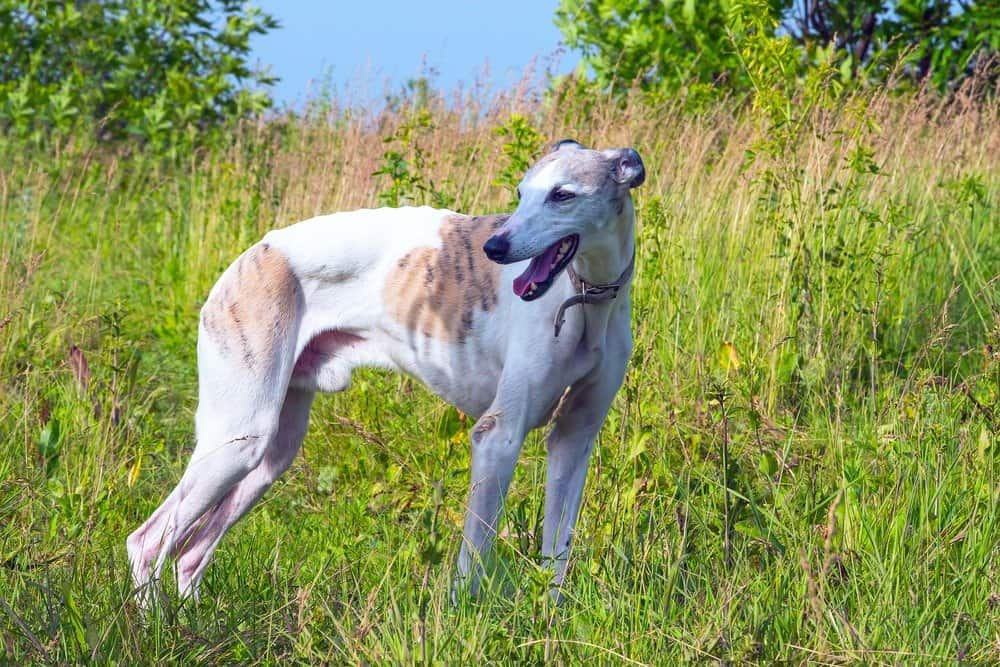
According to the AKC, you can expect your greyhound to weigh 60-70 pounds, depending on if they are male or female.
©Proshkin Aleksandr/Shutterstock.com
When Should My Greyhound Be Spayed or Neutered?
Increasingly, researchers are confirming that the question of spaying and neutering dogs, especially at young ages, is quite complex. A growing body of evidence is connecting early spay and neutering, especially among large dog breeds, with increased risks of developing a range of health issues such as joint and bone diseases and certain cancers. While altering your pet can eliminate the risk of some reproductive cancers, modern research demonstrates a range of health risks.
Dog guardians should have careful conversations with informed veterinarians on when or if to perform this procedure for their specific dog. Since the greyhound is not a particularly common breed in the U.S., most large-scale studies don’t include this breed in their research on the health effects of early spay/neuter.
However, before setting an early spay or neuter appointment, because the greyhound is a large breed with a unique body plan, it’s important to seek out a consultation with a vet up-to-date on modern research. This consultation will help you make a better, more informed decision about the health of your canine companion.
Greyhound Progression: When Should My Greyhound be House Trained?
You can begin house training your greyhound puppy at 8 weeks of age. It’s important to understand that puppies can only hold their bowels and bladder for a short amount of time. Typically, a 2-month-old greyhound needs to eliminate about every 2 hours during the day. To best ensure potty training, it’s important to take them outside consistently before this mark. You can also use potty pads inside to aid in your training and reduce the risks of accidents indoors. It’s crucial to make potty training an enjoyable, positive experience. You don’t want to punish accidents as this can damage your relationship with your pup, scare and confuse your puppy, and drive them to hide where they are eliminated. Instead, practice consistency and provide lots of love, treats, and play when your puppy goes in the right spot.
If you are adopting a rescued ex-racing greyhound, the concept of house training may be foreign to your new adoptee. Many of these dogs spent the majority of their lives in kennels and were not regularly taken out on walks. It can take longer to help adult dogs learn a potty routine, but it’s achievable. The principles are the same, and you want to stick with using support, praise, and consistency, and avoid punishing or making a big deal out of accidents. You may also find a rescued, adult greyhound to adopt who spent time in a foster home where they learned house training. In this case, you’ll just want to prepare for a possible regression in a new environment and practice patience and compassion as they adjust to their new home.
When Should My Greyhound Stop Eating Puppy Food
Since your greyhound is a large breed dog, you’ll want to continue feeding them puppy food until the age of 12-14 months.
It’s crucial to feed a properly formulated puppy food with about 22-26% protein while they are actively growing. Feeding the right amount of healthy, balanced food will help ensure proper development and can prevent joint and bone issues. While they are eating puppy food, especially under the age of 6 months, you’ll want to feed them 3-4 times per day. Once they reach adulthood, you can feed them 2-3 times per day. Make sure to always have fresh, clean water available for your greyhound.
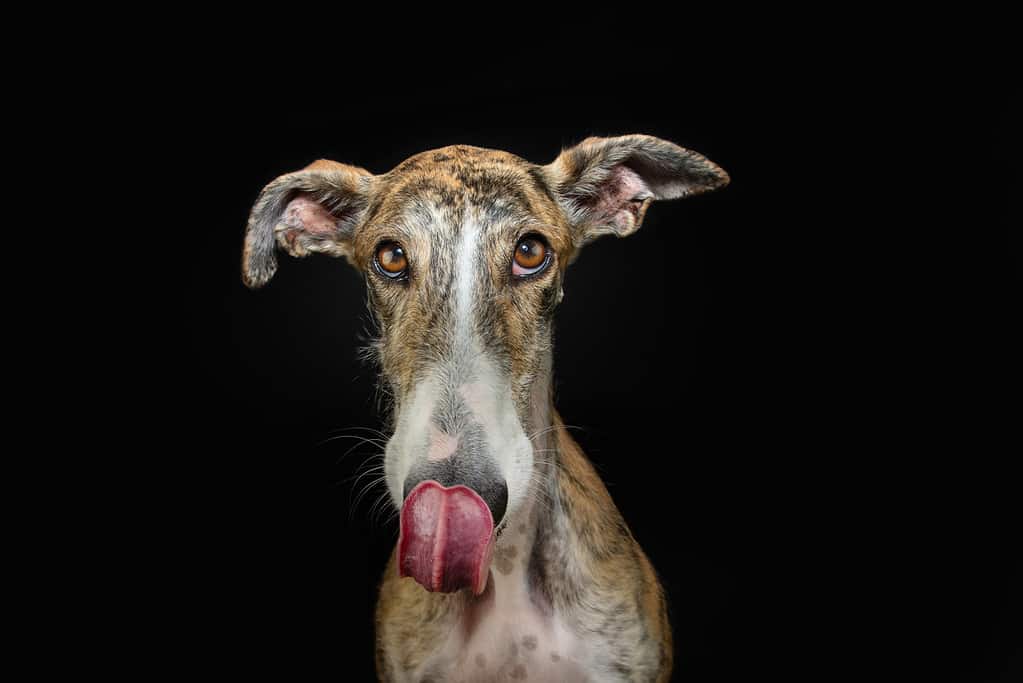
You can begin switching your greyhound to adult food at about 12-14 months old.
©smrm1977/iStock via Getty Images
Greyhound Progression: When Will My Greyhound Puppy Start Losing Teeth?
Your greyhound puppy should start losing their set of 28 baby teeth around 12-14 weeks old. During this time, their primary set of teeth fall out and permanent, adult teeth begin erupting from their gums. Once they reach about 6 months of age, your greyhound should have a full set of 42 adult, permanent teeth.
Teething
As your greyhound puppy loses their baby teeth and the adult teeth erupt, you’ll likely notice an increase in chewing. During this process of teething it’s important to provide them with an array of acceptable chewing items of various textures, especially rubber-like rings or frozen carrots to sink their teeth in.
If you find your greyhound puppy chewing on an inappropriate item, it’s important to trade it for a suitable toy. The reason is twofold: 1. chewing is a species-specific need for your puppy and 2. if you only take items away, you can damage your relationship and cause habitual resource guarding to develop.
When Should I Start Training My Greyhound?
If you adopt your Greyhound at a young age, you can begin rewarding, positive education with your puppy at about 8 weeks old. When they are this young, training sessions should only last a couple of minutes. From the start, you’ll want to set the foundation for learning as fun and achievable. It’s also important to understand that ethical training is simply one aspect of raising a puppy, and unfortunately, it is often overemphasized compared to supportive, well-rounded socialization and developing a secure attachment bond between the puppy and primary caregiver(s).
Supportive Socialization
The early socialization period lasts 3-12 weeks in puppies. During this time, your greyhound puppy’s brain is the most primed for learning about their environment and making lots of neural connections. It’s vitally important to support daily new experiences that incorporate a new sight, sound, smell, taste, sensation, or social interaction. These experiences should not be forceful or make your puppy feel overwhelmed. A little bit of stress can help us learn, but putting your puppy into a situation that is acutely stressful or scary will set them back and damage their confidence. So, just make sure to gently introduce new experiences and let your puppy set the pace.
Forming a Secure Attachment Bond
In addition to fun, rewarding education sessions and supportive socialization, you’ll also want to focus on forming a secure attachment bond with your greyhound. Studies demonstrate that dogs benefit from this type of bond formation in which they understand that their primary caregiver is a consistent source of comfort and safety. Your greyhound pup will feel more confident in socially processing new environments, navigating an array of social interactions, and exploring the world around them with you as their consistent base of support.
To achieve this, it’s crucial to be consistent, comfort your pup when they are nervous or afraid, offer lots of free affection and rewards, and not push your puppy into overwhelming situations. It also means learning canine body language and understanding when to help your pup exit a situation or move further away to where they feel more able to confidently and comfortably process their environment.
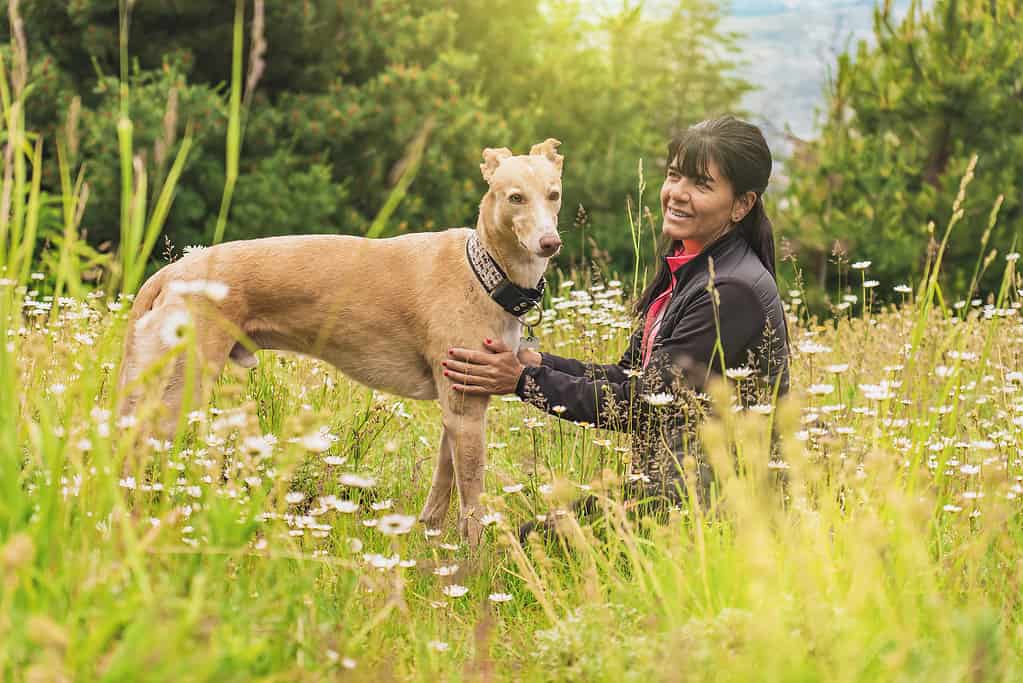
Forming a secure attachment bond will help your greyhound move through the world more confidently and comfortably.
©daniromphoto/iStock via Getty Images
Greyhound Progression: What Cues Should I Teach My Greyhound First?
Whether you are adopting a greyhound puppy or an adult, it’s important to facilitate a consistent recall cue. To best achieve this, you’ll want your pup to be excited to return to you because you have a strong relationship and you offer lots of treats, snuggles, play, and toys when they come back to you when called. You can start this from a small distance of only a few steps away and increase the distance and distraction levels to prove this skill.
Repeated sitting can be difficult for greyhounds due to their confirmation. Instead of using the sit cue as a default behavior, you can replace this with a “wait” or “watch me” cue. These skills serve the same purpose of asking your pup to focus their attention on you and be temporarily still, but it does so in a way that allows your greyhound to choose how they want to position themselves.
Common Health Issues Your Greyhound Might Experience
Greyhounds have an average lifespan of 10-13 years. They are prone to developing a few genetic diseases that occur in other dog breeds but are particularly prevalent in this breed. These health concerns include the following: dental issues such as tooth decay and an aggressive bone cancer.
- Dental issues such as periodontal and paradental diseases.
- An aggressive bone cancer called osteosarcoma
- Kidney disease
- Hypothyroidism
- An abnormal growth of tissues over the cornea called pannus
Additionally, greyhounds are known for being sensitive to several medications and veterinary procedures. One particular risk that greyhounds face is malignant hyperthermia, which can occur as a reaction to gas anesthesia. This reaction can be fatal as the body heats over 106 degrees Fahrenheit, making procedures done under gas anesthesia riskier for this breed. Typically, vets will perform pre-operative blood tests to gain a better understanding of how your specific greyhound may react to anesthesia. Additionally, the clinic will check your pup’s temperature before, several times during, and after the procedure. If the procedure is elective, they may choose to postpone or cancel the surgery based on blood test results, which evaluate liver and kidney levels, among other parameters.
Picture of Greyhound Puppies
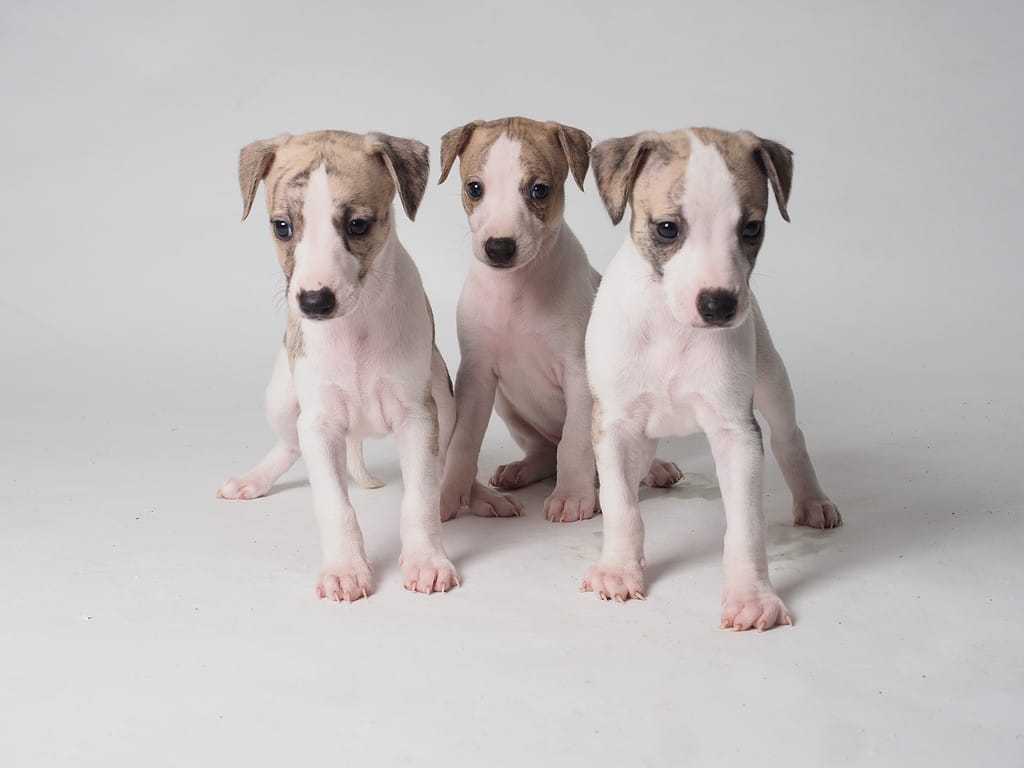
A litter of adorable, curious greyhound puppies.
©marcelinopozo/iStock via Getty Images
Picture of a 6-Month-Old Greyhound Puppy
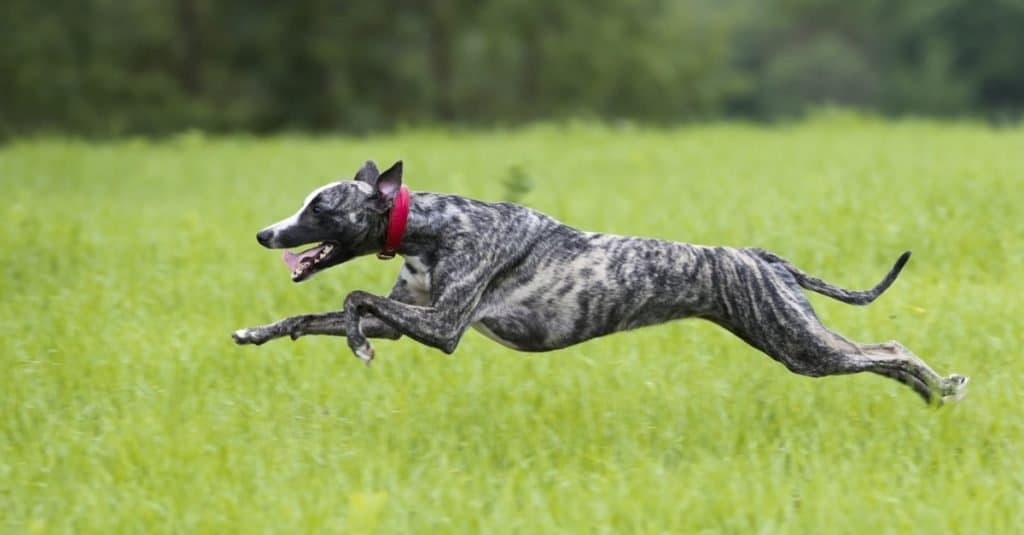
A 6-month-old greyhound exercising in a field.
©Liliya Kulianionak/Shutterstock.com
Picture of an Adult Greyhound
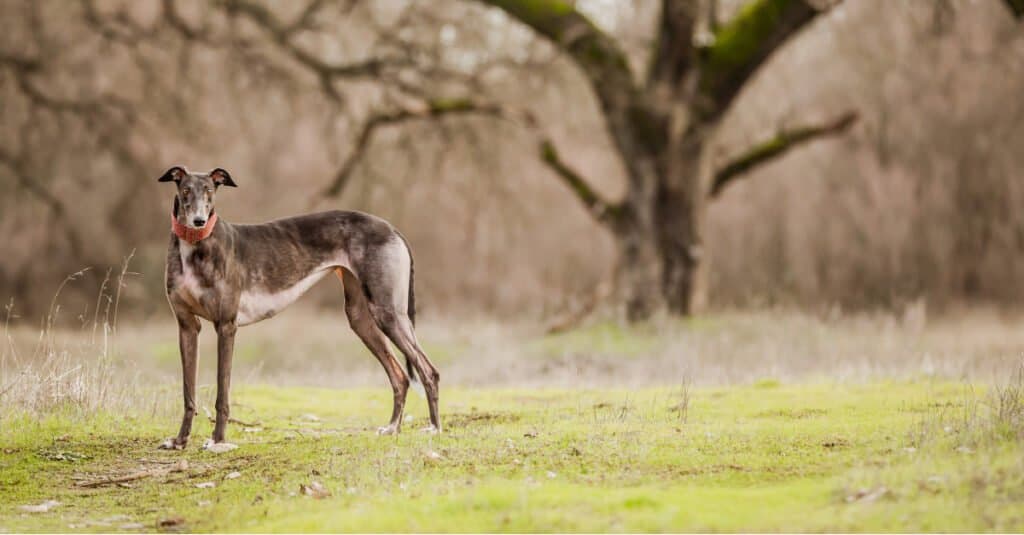
An alert, adult greyhound standing in a field.
©iStock.com/Photography by Adri
The photo featured at the top of this post is © Proshkin Aleksandr/Shutterstock.com
Ready to discover the top 10 cutest dog breeds in the entire world?
How about the fastest dogs, the largest dogs and those that are -- quite frankly -- just the kindest dogs on the planet? Each day, AZ Animals sends out lists just like this to our thousands of email subscribers. And the best part? It's FREE. Join today by entering your email below.
Thank you for reading! Have some feedback for us? Contact the AZ Animals editorial team.






